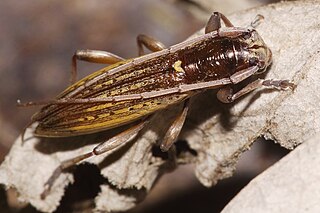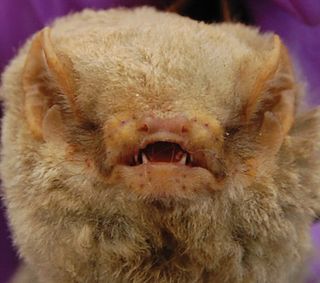The name Egeria may refer to:

The longhorn beetles (Cerambycidae), also known as long-horned or longicorns, are a large family of beetles, with over 35,000 species described.

13 Egeria is a large main-belt G-type asteroid. It was discovered by Annibale de Gasparis on November 2, 1850. Egeria was named by Urbain Le Verrier, whose computations led to the discovery of Neptune, after the mythological nymph Egeria of Aricia, Italy, the wife of Numa Pompilius, second king of Rome.

USS Egeria (ARL-8) was one of 39 Achelous-class landing craft repair ships built for the United States Navy during World War II. Named for Egeria, she was the only U.S. Naval vessel to bear the name.
The Bibundi bat is a species of vesper bat in the family Vespertilionidae. It can be found in Cameroon, Republic of the Congo, Uganda, and the Dzanga-Sangha Special Reserve.

Xylotoles is a genus of flat-faced longhorns in the beetle family Cerambycidae. There are more than 15 described species in Xylotoles found mainly in New Zealand, Australia, and surrounding islands.

Elodea densa, the large-flowered waterweed or Brazilian waterweed, is a species of Elodea native to warm temperate South America in southeastern Brazil, Argentina, Chile and Uruguay. It is considered a problematic invasive species due to its use in home aquariums and subsequent release into non-native ecosystems.

Glauconycteris is a genus of vespertilionid bats found in Africa.

Trichocanonura is a genus of flat-faced longhorns in the beetle family Cerambycidae. This genus has a single species, Trichocanonura linearis, found in the southwestern United States and Mexico.

Achryson is a genus in the longhorn beetle family Cerambycidae. There are about 17 described species in Achryson, found mainly in the Neotropics.

Bimiini is a tribe of beetles in the subfamily Cerambycinae, containing the following genera and species:
Taygayba venezuelensis is a species of beetle in the family Cerambycidae, the only species in the genus Taygayba. Both the genus and species were described in 1998 by Brazilian entomologists Ubirajara Ribeiro Martins and Maria Helena Mainieri Galileo. As its species epithet suggests, the beetle is found in Venezuela.

Plocaederus is a genus of Long-Horned Beetles in the beetle family Cerambycidae. This genus has a single species, Plocaederus bellator. It is known from the South American countries Brazil, Ecuador, Guyana, French Guiana, Paraguay, and Suriname.
Pseudomethia is a genus of typical longhorn beetles in the family Cerambycidae. This genus has a single species, Pseudomethia arida, found in California, Arizona, and northwest Mexico.

Tristachycera is a genus of typical longhorn beetles in the family Cerambycidae. This genus has a single species, Tristachycera viridis, found in Central America.

Carneades is a genus of long-horned beetles in the subfamily Lamiinae. There are about 15 described species in Carneades, found in Mexico, Central America, and South America.
Domitia is a genus of Long-Horned Beetles in the beetle family Cerambycidae. There are about seven described species in Domitia, found in Sub-Saharan Africa.
Graciella is a genus of flat-faced longhorns in the beetle family Cerambycidae. There are about 13 described species in Graciella, found in Sub-Saharan Africa.
Myagrus irroratus is a species of beetle in the family Cerambycidae, and the type species of its genus. It was described by Heller in 1924, originally under the genus Xoes. It is known from the Philippines.
Paradiallus irroratus is a species of beetle in the family Cerambycidae, and the type species of its genus. It was described by Heller in 1924, originally under the genus Xoes. It is known from the Philippines.











